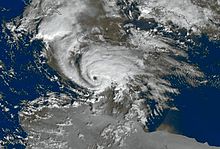| Revision as of 19:43, 15 December 2013 edit70.134.229.223 (talk) awkward wording --> encyclopedic wording; WP:MOS; dab; grammar← Previous edit | Revision as of 19:49, 15 December 2013 edit undo70.134.229.223 (talk) WP:USERGENERATED - other wikis are not reliable sourcesNext edit → | ||
| Line 5: | Line 5: | ||
| ==Origin and local sub futures{{clarify}}== | ==Origin and local sub futures{{clarify}}== | ||
| About once or twice per year,<ref>http://www.uib.es/depart/dfs/meteorologia/METEOROLOGIA/ANGEL/ProceedingEUMETSAT07.pdf</ref><ref>ftp://texmex.mit.edu/pub/emanuel/PAPERS/Romero_Emanuel_2013.pdf</ref> usually during fall when the Mediterranean is still warm, a ] takes on the characteristics of a subtropical storm with clouds wrapped around an eye, intense ] activity, strong surface winds, and warm temperature in the center clouds. In a satellite image such a system can resemble a tropical storm, but without the dimensions or power. One example is a Medicane that threatened ] from November 1, 2011 to November 9, 2011 and produced up to 800 mm of rain.<ref>http://www.meteo.fr/cic/meetings/2012/ERAD/presentations/thursday/13A-4.pdf</ref> Many other storms have been classified as Medicanes.<ref>http://scienceandworldevents.wikia.com/Mediterranean_tropical_cyclone</ref> | About once or twice per year,<ref>http://www.uib.es/depart/dfs/meteorologia/METEOROLOGIA/ANGEL/ProceedingEUMETSAT07.pdf</ref><ref>ftp://texmex.mit.edu/pub/emanuel/PAPERS/Romero_Emanuel_2013.pdf</ref> usually during fall when the Mediterranean is still warm, a ] takes on the characteristics of a subtropical storm with clouds wrapped around an eye, intense ] activity, strong surface winds, and warm temperature in the center clouds. In a satellite image such a system can resemble a tropical storm, but without the dimensions or power. One example is a Medicane that threatened ] from November 1, 2011 to November 9, 2011 and produced up to 800 mm of rain.<ref>http://www.meteo.fr/cic/meetings/2012/ERAD/presentations/thursday/13A-4.pdf</ref> Many other storms have been classified as Medicanes.<ref>http://scienceandworldevents.wikia.com/Mediterranean_tropical_cyclone</ref>{{Verify credibility|date=December 2013}} | ||
| ] | ] | ||
Revision as of 19:49, 15 December 2013
| This article or section is in a state of significant expansion or restructuring. You are welcome to assist in its construction by editing it as well. If this article or section has not been edited in several days, please remove this template. If you are the editor who added this template and you are actively editing, please be sure to replace this template with {{in use}} during the active editing session. Click on the link for template parameters to use.
This article was last edited by 70.134.229.223 (talk | contribs) 11 years ago. (Update timer) |

A Medicane is a subtropical or tropical cyclonic storm system similar to a hurricane that occurs over the Mediterranean Sea. Medicanes do not usually reach hurricane strength, but may produce substantial damage because of their location near highly populated areas around the Mediterranean. Although the Mediterranean is not an officially designated tropical cyclone basin, cyclones having properties of a tropical cyclone occasionally form in the mid-latitudes and on rare occasions over the Black Sea. A medicane is small, has an axisymmetric cloud structure, generates strong winds, heavy rains, and thunderstorms. This phenomenon has often been named "Medicane" or "Tropical-like Mediterranean Storm (T.M.S.)".
Origin and local sub futures
About once or twice per year, usually during fall when the Mediterranean is still warm, a depression takes on the characteristics of a subtropical storm with clouds wrapped around an eye, intense thunderstorm activity, strong surface winds, and warm temperature in the center clouds. In a satellite image such a system can resemble a tropical storm, but without the dimensions or power. One example is a Medicane that threatened France from November 1, 2011 to November 9, 2011 and produced up to 800 mm of rain. Many other storms have been classified as Medicanes.

Most Medicanes form in the western Mediterranean region, although some form in the Ionian region. In fall there is a steady increase in Medicane formation in the western Mediterranean region and a decrease in January; in the Ionian region it is the reverse - Medicanes are much less frequent in fall than in January or February.
Evolution and life cycle
Medicanes usually have a life cycle between 12 hours and 5 days and travel between ~700 and ~3,000 km. Although similar to tropical cyclones in the Caribbean or the Atlantic, their evolution is different. Unlike hurricanes, which often evolve from a tropical wave, Medicanes often develop from a cold upper-level low. In the first phase there is a baroclinic development. The second phase is much more like a convective tropical air-sea interaction with sea temperatures above 26°C (78.8°F).
References
- ftp://texmex.mit.edu/pub/emanuel/PAPERS/Romero_Emanuel_2013.pdf
- http://en.ria.ru/strange/20120127/170988652.html
- http://link.springer.com/article/10.3103%2FS1068373908040067#
- http://query.nytimes.com/gst/abstract.html?res=F4061EF73B5A12738DDDAF0994DB405B868CF1D3
- http://www.uib.es/depart/dfs/meteorologia/METEOROLOGIA/ANGEL/ProceedingEUMETSAT07.pdf
- ftp://texmex.mit.edu/pub/emanuel/PAPERS/Romero_Emanuel_2013.pdf
- http://www.meteo.fr/cic/meetings/2012/ERAD/presentations/thursday/13A-4.pdf
- http://scienceandworldevents.wikia.com/Mediterranean_tropical_cyclone
- http://www.academia.edu/4775469/A_long-term_climatology_of_medicanes
- http://www.academia.edu/4775469/A_long-term_climatology_of_medicanes
- http://www.hvonstorch.de/klima/pdf/cavicchia-2011.pdf
- http://www.uib.es/depart/dfs/meteorologia/METEOROLOGIA/MEDICANES/introduction.html
- convective tropical-like activity and air-sea interaction
External links
- Official EUMETSAT Website
- EUMETSAT weather satellite viewer
- Website monitoring Medicane activity
- Scientific article about Medicanes
| Cyclones and anticyclones of the world (centers of action) | |||||||||||||||||||||||||||||||||||||||||||||||
|---|---|---|---|---|---|---|---|---|---|---|---|---|---|---|---|---|---|---|---|---|---|---|---|---|---|---|---|---|---|---|---|---|---|---|---|---|---|---|---|---|---|---|---|---|---|---|---|
| Concepts | |||||||||||||||||||||||||||||||||||||||||||||||
| Anticyclone |
| ||||||||||||||||||||||||||||||||||||||||||||||
| Cyclone |
| ||||||||||||||||||||||||||||||||||||||||||||||